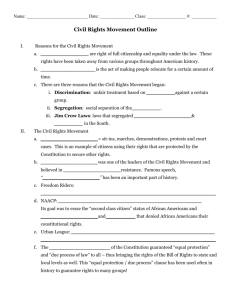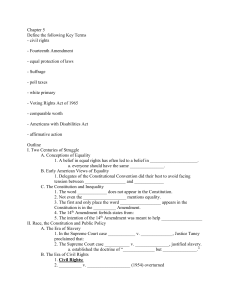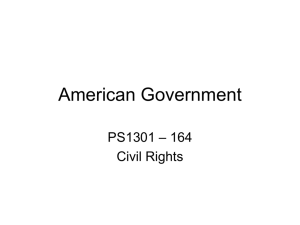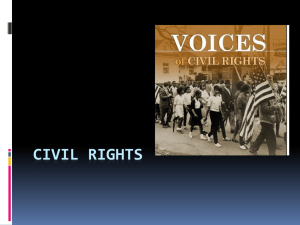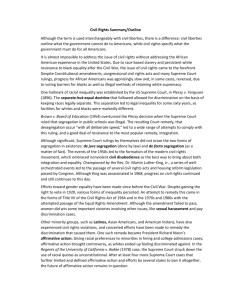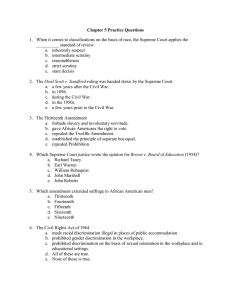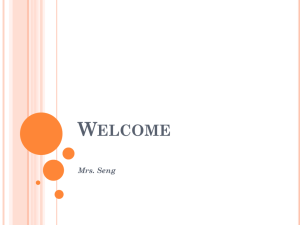Chapter 5 Civil Rights Cornell Notes
advertisement
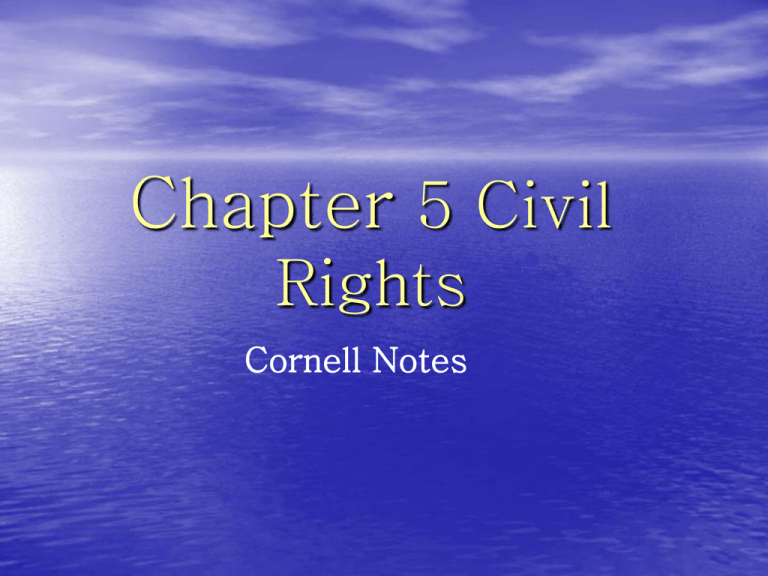
Chapter 5 Civil Rights Cornell Notes I. Introduction Topic / Main Ideas Details A. Civil rights • are policies that extend basic rights to groups historically subject to discrimination. B. Debates on inequality in America • center on racial discrimination, gender discrimination, and discrimination based on age, disability, sexual orientation, and other factors. II. Racial Equality: Two Centuries of Struggle Topic / Main Ideas A. Conceptions of Equality B. Early American Views of Equality C. The Constitution and Inequality Details • Equality of opportunity: everyone should have the same chance. • Equal results or rewards: everyone should have the same rewards. • Jefferson’s statement in the Declaration of Independence that “all men are created equal” did not mean that he thought there were no differences among people. • Women’s rights received even less attention than did slavery at the Convention. • The Fourteenth Amendment provides for equal protection of the laws, resulting in expansive constitutional interpretation. II. Racial Equality: Two Centuries of Struggle Summary:_______________________________________________________ _______________________________________________________________ ________________________________________________________________ ________________________________________________________________ Question A 1. Policies that extend basic rights to groups historically subject to discrimination are known as ________________________ 2. The concept that everyone should have the same chance is called equality of _____________ Question B Thomas Jefferson, who wrote in the Declaration of Independence “We hold these truths to be self evident, that all men are created equal,” believed A) that blacks were genetically inferior to whites. B) that there were no differences among human beings. Question C The Fourteenth Amendment specifically forbids the states from denying to anyone A) the right to vote on the basis of race. B) equal protection of the laws. III. Race, the Constitution, and Public Policy Topic / Main Ideas Details A. The Era of Slavery • • Scott v. Sandford (1857) upheld slavery. The Civil War and the Thirteenth Amendment ended slavery. B. The Era of Reconstruction and Resegregation • • Jim Crow laws (segregation laws) established in the South. Plessy v. Ferguson justified segregation through the "equal but separate“ doctrine. C. The Era of Civil Rights • Brown v. Board of Education (1954) overturned Plessy and ended legal segregation. • The civil rights movement organized to end the policies and practice of segregation. • The Civil Rights Act of 1964 made racial discrimination illegal in places of public accommodation and in employment. III. Race, the Constitution, and Public Policy Topic / Main Ideas Details A. The Era of Slavery • • Scott v. Sandford (1857) upheld slavery. The Civil War and the Thirteenth Amendment ended slavery. B. The Era of Reconstruction and Resegregation • • Jim Crow laws (segregation laws) established in the South. Plessy v. Ferguson justified segregation through the "equal but separate“ doctrine. C. The Era of Civil Rights • Brown v. Board of Education (1954) overturned Plessy and ended legal segregation. • The civil rights movement organized to end the policies and practice of segregation. • The Civil Rights Act of 1964 made racial discrimination illegal in places of public accommodation and in employment. III. Race, the Constitution, and Public Policy Topic / Main Ideas D. Getting and Using the Right to Vote E. Other Minority Groups 1. Native Americans 2. Hispanic Americans Details • Suffrage was guaranteed to African Americans by the Fifteenth Amendment in 1870. • Southern practices to deny African American suffrage (literacy tests, grandfather clause, poll taxes, and the White primary) were gradually struck down by the Supreme Court and the Twenty fourth Amendment. • The Voting Rights Act of 1965 prohibited any government from using voting procedures that denied a person the vote on the basis of race or color. • The oldest minority group in America, but they were not made U.S. citizens until 1924. • Have displaced African Americans as the largest minority group, comprising about 13 percent of the U.S. population. III. Race, the Constitution, and Public Policy Topic / Main Ideas 3. Asian Americans: 4. Other Groups Details • a. The fastest growing minority group, they now comprise four percent of the U.S. population. • b. During World War II, the U.S. government rounded up more than 100,000 Americans of Japanese descent and placed them in internment encampments known as “war relocation centers.” • c. The Supreme Court upheld the internment as constitutional in Korematsu v. United States (1944), but Congress later provided benefits for the former internees (which still have not been distributed). • a. There are more than 1.2 million persons of Arab ancestry in the United States. III. Race, the Constitution, and Public Policy Question A 1. In the case of Dred Scott v. Sandford, the United States Supreme Court A) ruled that all adult African-American men had a right to vote under the Constitution. B) ruled that a black man, slave or free, was “chattel,” and upheld slavery itself as constitutional. 2. Slavery was declared unconstitutional by the_________ Question B 1. Jim Crow laws A) imposed legal segregation on African Americans in the South after the Civil War. B) were an attempt to reimpose slavery in the South after the Civil War. 2. In the case of Plessy v. Ferguson, A) housing discrimination was forbidden. B) the principle of “separate but equal” was used to justify segregation. Question C The Brown v. Board of Education decision overturned the Supreme Court’s 1896 ruling in __ Question D The Civil Rights Act of 1964 A) guaranteed minority groups the right to vote. B) guaranteed equal access to hotels, restaurants, and other public accommodations. Question E In the case of Korematsu v. United States, the Supreme Court A) ruled that the removal of Japanese Americans from the west coast and their placement in internment camps during World War II was barbaric and unconstitutional. D) upheld the constitutionality of the removal of Japanese Americans from the west coast and their placement in internment camps during World War II. IV. Women, the Constitution, and Public Policy Topic / Main Ideas Details A. The Battle for the Vote • the Nineteenth Amendment gave women the right to vote. B. The "Doldrums": 1920-1960 • Public policy toward women was dominated by protectionism. The Equal Rights Amendment was first introduced in Congress in 1923. • • Reed v. Reed (1971) ruled that any "arbitrary" sex-based classification violated the Fourteenth Amendment. • Craig v. Boren (1976) established a "medium scrutiny" standard. D. Women in the Workplace • Congressional acts and Supreme Court decisions have reduced sex discrimination in employment and business activity. E. Wage Discrimination and Comparable Worth: • Women should receive equal pay for jobs of "comparable worth." C. The Second Feminist Wave IV. Women, the Constitution, and Public Policy Topic / Main Ideas Details F. Women in the Military • • Only men must register for the draft. Statutes and regulations prohibit women from serving in combat. G. Sexual Harassment • The Supreme Court has ruled that sexual harassment that is so pervasive as to create a hostile or abusive work environment is a form of sex discrimination. IV. Women, the Constitution, and Public Policy Question A ”Coverture” S) was the combination of electric shock therapy and drugs once used to “cure” homosexuals of their homosexuality. T) was the legal doctrine that deprived married women of any identity separate from that of their husbands. Question B The ________ gave women the constitutional right to vote. Question C From about 1920-1960, the feminist movement U) experienced great growth and activity. D) was in a period of hibernation. Question D In ________, the Supreme Court ruled that any “arbitrary” sex -based classification violated the equal protection clause. H) Craig v. Boren A) Reed v. Reed Question E The ________ banned gender discrimination in employment by law. R) Civil Rights Act of 1964 D) Gender Equity Act of 1972 Question F The issue of ________ deals with women seeking to redress the fact that jobs traditionally held by men tend to pay far greater salaries than jobs requiring similar skills but are traditionally held by women. Y) gender equality A) comparable worth Question G Which of the following statements about women in the military is FALSE? B) Women, as well as men, are now required to register for the draft. C) Statutes and regulations prohibit women from serving in most combat situations. Question G In 1993, the Supreme Court ruled that sexual harassment is sex discrimination that violates the Civil Rights Act when A) the target objects a second time to touching, body language, or dirty talk. C) the workplace environment becomes hostile or abusive. V. Newly Active Groups Under the Civil Rights Umbrella) Topic / Main Ideas A. Civil Rights and the Graying of America B. Civil Rights and People with Disabilities C. Gay and Lesbian Rights Details • People in their eighties comprise the fastest growing age group in this country. • Since 1967, Congress has passed several laws that ban various types of age discrimination. • It is not clear what the fate of the gray liberation movement will be as its members approach the status of a minority majority. • :the Americans with Disabilities Act of 1990 required employers and public facilities to make reasonable accommodations and prohibited employment discrimination against the disabled. • Homosexual activity is illegal in some states, and homosexuals often face prejudice in hiring, education, access to public accommodations, and housing. • Homophobia (fear and hatred of homosexuals) has many causes, and homosexuals are often seen as safe targets for public hostility. V. Newly Active Groups Under the Civil Rights Umbrella) Summary:_______________________________________________________ _______________________________________________________________ ________________________________________________________________ ________________________________________________________________ Question A The fastest growing age group in the American population is A) people in their 80s. B) baby-boomers. Question B The “gray liberation” movement refers to A) those fighting for the rights of the elderly. B) those fighting for equal rights and justice for the disabled. Question C In 1990, Congress enacted the ________, a far-reaching law to protect a particular group of Americans from discrimination, ignoring those who claimed the price tag would be too high. Opposition to Civil Rights laws for the handicapped has been justified primarily on the basis of the A) inability of disabled persons to handle most employment requirements. B) high cost of programs to help the disabled. Homophobia refers to A) fear and hatred toward gay men and lesbian women. B) the tendency to be sexually attracted to members of oneʹs own sex. VI. Affirmative Action Topic / Main Ideas Details A. Affirmative action • involves efforts to bring about increased employment, promotion, or admission for members of groups that have suffered invidious discrimination. B. In Regents of the University of California v. Bakke (1978) • the Court ruled against the practice of setting aside a quota of spots for particular groups. C. The Courts • have been more deferential to Congress than to local government in upholding affirmative action programs. • the Court ruled that federal programs that classify people by race are constitutional only if they are "narrowly tailored“ to accomplish a "compelling governmental interest." • view affirmative action as reverse discrimination. D. In Adarand Constructors v. Peña (1995) E. Opponents VI. Affirmative Action Summary:_______________________________________________________ _______________________________________________________________ ________________________________________________________________ ________________________________________________________________ Question A Affirmative action seeks to move beyond A) equal results to equal opportunity. B) equal opportunity to equal results. Question B The strongest and most controversial form of affirmative action is A) busing. B) numerical quotas. In the case of Regents of the University of California v. Bakke, the United States Supreme Court A) upheld all affirmative action programs as justified and constitutional. B) upheld affirmative action programs, but limited their scope, and outlawed racial quota set-asides. Question C When proposition 209 was passed in California in 1996, it banned A) affirmative action in public hiring, contracting, and educational admissions. B) affirmative action in federal hiring. Question D Affirmative action programs are referred to by critics as A) negative reaction. B) reverse discrimination. VII. Understanding Civil Liberties and the Constitution Topic / Main Ideas A. Civil Rights and Democracy B. Civil Rights and the Scope of Government Details • Equality tends to favor majority rule, but equality threatens individual liberty in situations where the majority wants to deprive the minority of its rights. • Majority rule is not the only threat to liberty: minorities have suppressed majorities as well as other minorities. • Even when they lacked the power of the vote, both African Americans and women made many gains by using other rights (such as the First Amendment freedoms) to fight for equality. • Civil rights laws increase the scope and power of government. • These laws place both restrictions and obligations on individuals and institutions—they tell individuals and institutions that there are things they must do and other things they cannot do. • Libertarians and those conservatives who want to reduce the size of government are uneasy with these laws (and sometimes hostile to them). • Civil rights is an area in which increased government activity in protecting basic rights can lead to greater checks on the government by those who benefit from such protections. VII. Understanding Civil Liberties and the Constitution Summary:_______________________________________________________ _______________________________________________________________ ________________________________________________________________ ________________________________________________________________ Question A Equality tends to favor majority rule but __________individual liberty in situations where the majority wants to deprive the minority of its rights. A) strengthens B) threatens Question B Civil rights ________ the scope of government A) increase B) decreases
